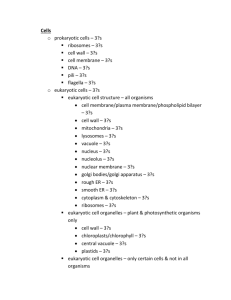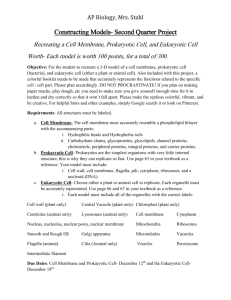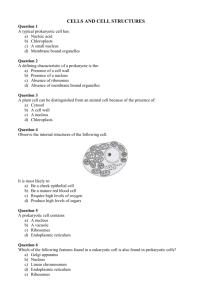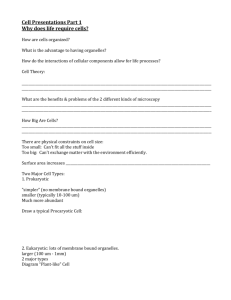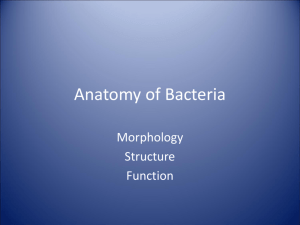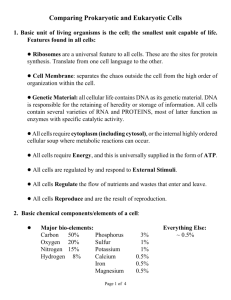Topic 2: Cells
advertisement
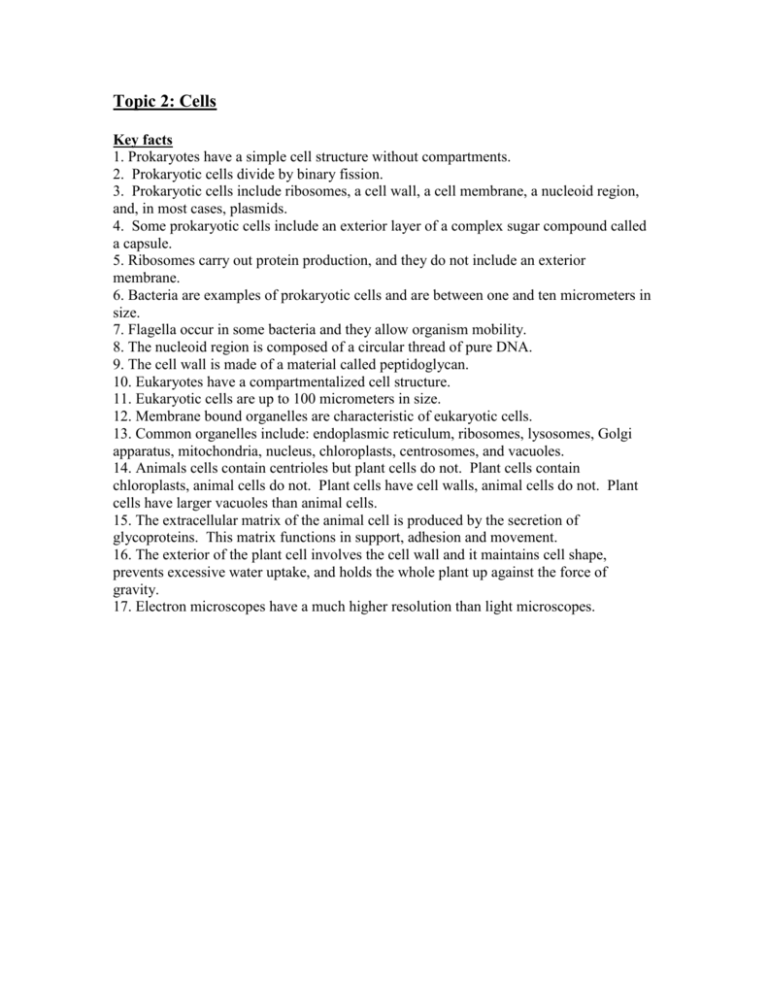
Topic 2: Cells Key facts 1. Prokaryotes have a simple cell structure without compartments. 2. Prokaryotic cells divide by binary fission. 3. Prokaryotic cells include ribosomes, a cell wall, a cell membrane, a nucleoid region, and, in most cases, plasmids. 4. Some prokaryotic cells include an exterior layer of a complex sugar compound called a capsule. 5. Ribosomes carry out protein production, and they do not include an exterior membrane. 6. Bacteria are examples of prokaryotic cells and are between one and ten micrometers in size. 7. Flagella occur in some bacteria and they allow organism mobility. 8. The nucleoid region is composed of a circular thread of pure DNA. 9. The cell wall is made of a material called peptidoglycan. 10. Eukaryotes have a compartmentalized cell structure. 11. Eukaryotic cells are up to 100 micrometers in size. 12. Membrane bound organelles are characteristic of eukaryotic cells. 13. Common organelles include: endoplasmic reticulum, ribosomes, lysosomes, Golgi apparatus, mitochondria, nucleus, chloroplasts, centrosomes, and vacuoles. 14. Animals cells contain centrioles but plant cells do not. Plant cells contain chloroplasts, animal cells do not. Plant cells have cell walls, animal cells do not. Plant cells have larger vacuoles than animal cells. 15. The extracellular matrix of the animal cell is produced by the secretion of glycoproteins. This matrix functions in support, adhesion and movement. 16. The exterior of the plant cell involves the cell wall and it maintains cell shape, prevents excessive water uptake, and holds the whole plant up against the force of gravity. 17. Electron microscopes have a much higher resolution than light microscopes. Complete the following. 1. Draw and label a diagram of the ultrastructure of Escherichia coli (E. coli), as an example of a prokaryote. The drawing should include the cell wall, plasma membrane, cytoplasm, pili, flagella, ribosomes, and nucleoid region (region containing naked DNA). 2. Draw and label a diagram of the ultrastructure of a liver cell as an example of an animal cell. The diagram should show free ribosomes, rough endoplasmic reticulum (rER), lysosome, Golgi apparatus, mitochondrion, and nucleus. (pg 23 of text book as reference) 3. Order the following from largest to smallest: molecules, bacteria, membranes, organelles, eukaryotic cell. 4. Name the function of the following prokaryotic cell parts: a. cell wall b. plasma membrane c. cytoplasm d. pili e. flagella f. ribosomes g. nucleoid 5. By what mechanism do prokaryotic cells divide? 6. Study some electron micrographs of bacterial cells. 7. How do ribosomes differ in prokaryotic and eukaryotic cells? 8. Describe the DNA of a prokaryotic cell. 9. Compare the location of genetic material in prokaryotic and eukaryotic cells. 10. What are thought to have been the first cell types on this planet? 11. What polysaccharide is stored in plant cells?_______________ in animal cells?______________ 12. Explain why animal cells may change shapes while plant cells are less likely to do so. 24. Describe the vacuole which occurs within plant cells. 25. Name three ways that animal and plant cells are similar. 26. Name three ways that animal and plant cells are different. 27. Explain why plants have mitochondria, even though they include chloroplasts. 28. How does the plant cell wall allow plants to maintain an upright position, not wilted? 29. Why would muscle cells have large numbers of mitochondria? 30. Name two organelles that are similar to prokaryotic cells. 31. What is the major component of plant cell walls? 32. Which major type of cell demonstrates compartmentalization?_________________ Why is this important? 34. Distinguish between the nucleolus and the nucleus. 35. In which organelle would one find grana, stroma, and thylakoids? 36. In which organelle would one find cristae and matrix? 37. Why would the Golgi apparatus have vesicles associated with it? 38. Name two functions of lysosomes. 39. Compare the structure and function of rough and smooth endoplasmic reticulum. 40. Why would liver cells have a large amount of sER? 41. Describe the major characteristics of the nuclear membrane.



